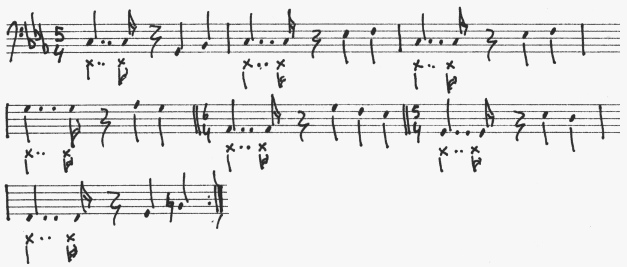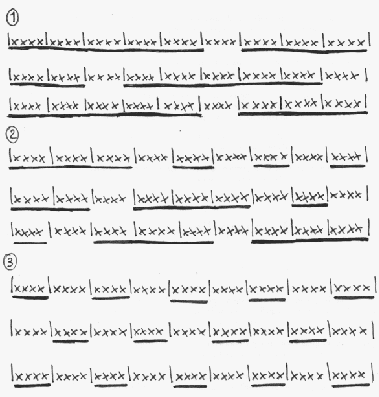The Holed Boot
Premise
The Holed Boot is a composition that more than any other before made
me understand the vastness, variety and the range of possibilities that
open up with a musical organization based on cycles.
This piece is formed by 3 cycles superposing each other in a closed
way (i.e., the end of a cycle corresponds to the end of
another) and within its structure there are elements that I had
never used before. These are: the use of a composite cycle, a
clear harmonic movement within one of the cycles and also,
umprecedently, one of the cycles is represented by an additional element
(in this case pauses) that superposes the other two cycles.
Considering all internal potential meanings of this work I decided to
write these notes to clarify all organization aspects that
build the base of the composition.
The material
Cycle(A):

This cycle is formed by 36 quarter notes divided into six 5/4
bars and one 6/4 bar. Within bars 5, 6 and 7 there is a clear harmonic
movement, even though the harmony is only implicit as the cycle is
made up by a sequence of single notes.
Cycle (B):
Rhythmic Sequence: 
Bb Melodic Sequence: 
This is a composite cycle made by the combination of a rhythmic and
a melodic sequence that don't have the same number of events superposing themselves in an open way. This means that the end
of the melodic sequence does not correspond to the end of the rhythmic
one. The result is a rhytmic sequences with an always different melodic
profile, and a melodic sequence with an always different rhythmic profile.
The rhythmic sequence is formed by 8 events with a total of 12 quarter
notes; after three repetitions it ends in a closed way on cycle (A) as
follows: 12 x 3 = 36
The melodic sequence is formed by 11 events and is built on an 8 notes
scale coming from the aeolian scale of C (key of cycle (A)) without the
key note, while the 7th major and the 11th# have been added.
The two sequences, melodic and rhytmic one, don't close each others and end
turning on a keynote after 9 rhytmic sequences. In this way the entire
cycle superposes itself in a closed way on 3 cycles (A).
Cycle (C): 
The Cycle (C) develops in units of 4/4, varying further the
perception of the rhythmic unit; this cycle is made up by 5 sub-cycles
each
of 27 units. Every sub-cyle superposes itself in a closed way with 3
cycles (A)
(one cycle (B)). Some of the units of (C) cycle are pauses in the other
two cycles. In fact the cycle (C) can be seen as a grid of pauses which
is applied laying upon the other two underlying cycles. At the end of
each sub-cycle the number of pauses increases, following this scheme:
1st sub-cycle: pause of 1 unit after 5 units
2nd sub-cycle: pause of 1 unit after 3 units and already existing pauses
3rd sub-cycle: pause of 1 unit after 1 unit
4th sub-cycle: negative of 2nd sub-cycle
5th sub-cycle: negative of 1st sub-cycle
Arrangement and Execution
Cycle (A) is played by bass and drums, while cycle (B) is played by clarinet and, in the rhytmic sequence, by cymbals.
Following parts have been added to complete the arrangement:
- a vamp deriving from the first two bars of cycle (A)
- an open collective improvisation on vamp
- a clarinet solo on the superposed structure of cycles (A) and (B) with
an harmonic variation on the 4th bar of cycle (A); with cymbals
following the clarinet on cycle (B) and bass and drums on cycle (A); to
perform this section percussions are splitted among two musicians,
one at the drums and one on cymbals.
Structure:
(A)x2 | (A)x3 + (B) | Vamp open | (A)x3 + (B) | Open solo on vamp | ((A)x3 + (B))x5 + (C) | Clarinet solo | (A)x3 + (B)



